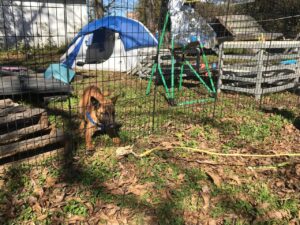
Many people ask, why can’t I just throw the ball and create play? The answer is that you can, but it all too often leads to problems. Most people that want to throw for a reward will quickly add many rules to otherwise fun and easy play. The dog must heel or sit and wait for the throw, and then immediately return to the handler with the object and release the thing they just worked so hard for. These rules are created often for the ease and convenience of the handler/trainer and not to increase the dog’s motivation. Play for young children and young dogs are defined by the lack of rules. Rules create a conflict between the dog’s desire (the reward object) and the handler’s desire (successful performance). For a detection dog the goal is to be obsessed with possession of the object–control can only be introduced when absolute motivation and arousal for the reward object have been achieved.
The four play methods demonstrated in this video:
- Loose chasing with a teaser pole
- Back tied with a teaser pole
- Play off of a wall
- Play behind a barrier
General rules for all this play:
- Chasing without winning the “prey” is a natural behavior. This builds the dog’s desire through the neuro-physiology of anticipation. A dog getting the object with every effort will not build the anticipation of finding the object. “The bunny never jumps into the dog’s mouth.”
- In the end, the dog must win and show advanced desire to independently possess the object. A dog that does not show independent possession is often the side affect of poorly directed play.
- You should adapt to the dog’s desires for various reward objects. Strive to build possession of different objects offered throughout development. Dogs stuck on a particular reward object often cannot achieve procurement standards.
- Rule of Thumb- Play should not typically last longer in minutes than the dog is months old. Most people tend to overdo it with their dogs and this often has unintended consequences.
- If you are not having fun during a play session, odds are neither is your dog.
- Control and play are initially at the opposite ends of the spectrum. We strive for dogs that are solely focused on getting access to and then possessing the reward object, so obedience or sensitivity to the handler can be counter-productive to this goal. “If the handler is so smart he should find his own bombs!”
- Continue to encourage possession even when the dog returns the object to the handler.

